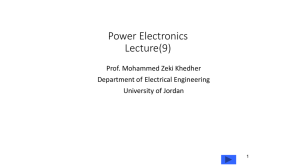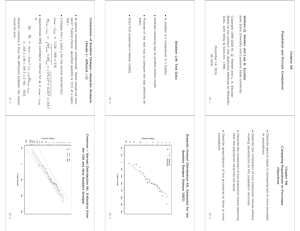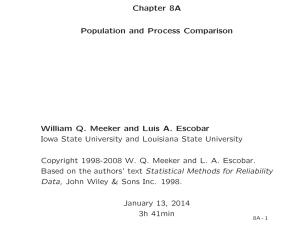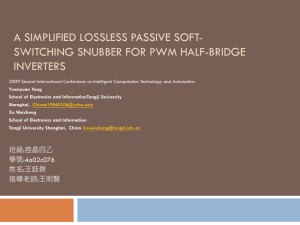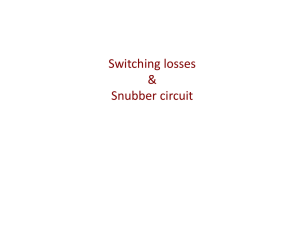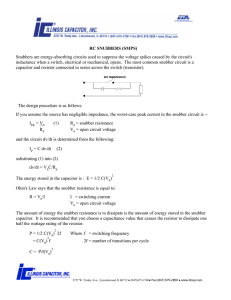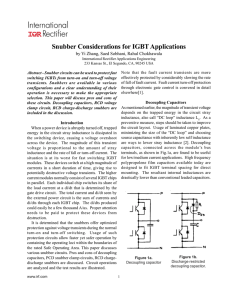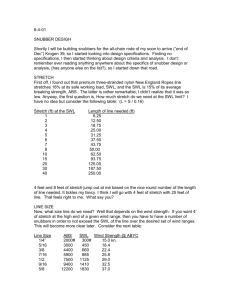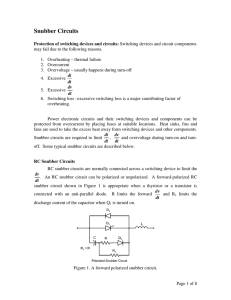Snubber Circuits
advertisement
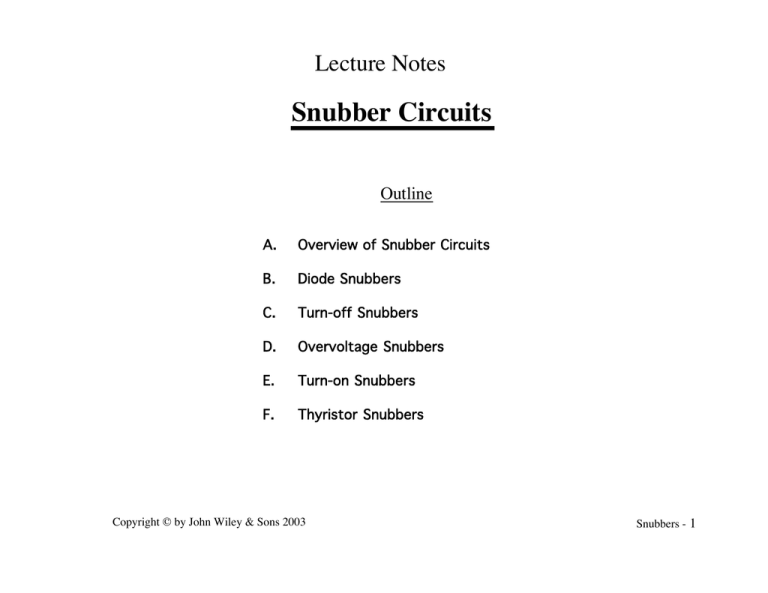
Lecture Notes Snubber Circuits Outline A. Overview of Snubber Circuits B. Diode Snubbers C. Turn-off Snubbers D. Overvoltage Snubbers E. Turn-on Snubbers F. Thyristor Snubbers Copyright © by John Wiley & Sons 2003 Snubbers - 1 Overview of Snubber Circuits for Hard-Switched Converters Function: Protect semiconductor devices by: • Limiting device voltages during turn-off transients • Limiting device currents during turn-on transients • Limiting the rate-of-rise (di/dt) of currents through the semiconductor device at device turn-on • Limiting the rate-of-rise (dv/dt) of voltages across the semiconductor device at device turn-off • Shaping the switching trajectory of the device as it turns on/off Copyright © by John Wiley & Sons 2003 Types of Snubber Circuits 1. Unpolarized series R-C snubbers • Used to protect diodes and thyristors 2. Polarized R-C snubbers • Used as turn-off snubbers to shape the turn-on switching trajectory of controlled switches. • Used as overvoltage snubbers to clamp voltages applied to controlled switches to safe values. • Limit dv/dt during device turn-off 3. Polarized L-R snubbers • Used as turn-on snubbers to shape the turn-off switching trajectory of controlled switches. • Limit di/dt during device turn-on Snubbers - 2 Need for Diode Snubber Circuit di + V d - Ls Rs Df Cs Io i Df (t) Io Df = d t V d Ls t I rr Sw v • Ls = stray inductance • S w closes at t = 0 • Rs - Cs = snubber circuit • Df (t) • Diode voltage without snubber Vd Ls t di Ls d t diLs Diode breakdown if Vd + Ls > BVBD dt Copyright © by John Wiley & Sons 2003 Snubbers - 3 Equivalent Circuits for Diode Snubber Ls + Vd - Diode snap-off cathode • Simplified snubber the capacitive snubber Rs Ls anode + + v Cs - Vd i Df - t • Rs = 0 • Worst case assumptiondiode snaps off instantaneously at end of diode recovery •v = -v Cs Df d2vCs • Boundary conditions - vCs(0+) = 0 and iLs(0+) = Irr LsCs = Vd Governing equation - dt2 + vCs • Copyright © by John Wiley & Sons 2003 Cs !LsCs Snubbers - 4 Performance of Capacitive Snubber • vCs(t) = Vd - Vd cos(wot) + Vd • • Cbase sin(wot) Cs wo = Vcs,max = 1 LsCs ; Ï Ì Vd 1!+! Ó È I ˘2 Í rr ˙ Cbase = Ls Í ˙ ÎV d˚ Cbase ¸ ˝ 1!+! ! ˛ Cs 5 4 V Cs,max Vd 3 2 1 0 0 0.2 0.4 0.6 0.8 1 1.2 1.4 1.6 1.8 2 C base Cs Copyright © by John Wiley & Sons 2003 Snubbers - 5 Effect of Adding Snubber Resistance Snubber Equivalent Circuit Ls i(t) - + V d - v Rs Df (t) + • Governing equation • Boundary conditions Cs i(0+) = Irr and Ls d2i di i + Rs + =0 2 dt C dt s Vd!-!IrrRs di(0+) = dt Ls Diode voltage as a function of time Vdf Vd (t) = - 1 wa = wo e-at sin(wat - f + z) ; Rs ≤ 2 Rb h!cos(f) Rs 1-!(a/!wo)2 ; a = 2!L ; wo = s È ˘ 1 Í (2-x) h ˙ -1 ; f = tan Í ˙ LsCs Î 4!-!hx2˚ Ls![Irr]2 Cs Rs Vd h = C ; x = R ; Rb = I ; Cb = ; z = tan-1(a/wa) 2 b b rr Vd Copyright © by John Wiley & Sons 2003 Snubbers - 6 Performance of R-C Snubber 3 • At t = tm vDf(t) = Vmax • tan-1(wa/a) f!-!x tm = + w ≥0 wa a • Vmax =1+ Vd • h = • Cs Cbase Ls!Irr2 Cbase = Vd2 x= and R V max V d Rbase Copyright © by John Wiley & Sons 2003 base 1 Rs Rbase = = 1.3 2 1!+!h-1!-!x exp(-atm) and R s,opt C s = Cbase R sI rr V d Vd Irr 0 0 1 Rs R base Snubbers - 7 2 Diode Snubber Design Nomogram Wtot 2 L s I r r /2 3 WR 2 L s I r r /2 0 2 0 V max 0 0 0 Vd 00 0 0 0 0 0 0 00 0 00 0 0 1 0 0 for R s = R s,opt 00 R s,op R base 0 0 Copyright © by John Wiley & Sons 2003 1 C s / Cbase 2 3 Snubbers - 8 Need for Snubbers with Controlled Switches Step-down converter L1 V d L s di dt L2 i L3 Switch current and voltage waveforms sw Sw Io i sw I + vsw - L s di dt o Io V d vsw to t • I rr L1 , L 2 , L 3 = stray inductances 1 t t 4 3 t 5 t6 Switching trajectory of switch • L s = L1 + L 2 + L 3 idealized switching loci i sw t 5 t6 turn-off to t1 turn-on t • Overcurrent at turn-on due to diode reverse recovery 4 t3 Vd Copyright © by John Wiley & Sons 2003 • Overvoltage at turn-off due to stray inductance vsw Snubbers - 9 Turn-off Snubber for Controlled Switches i + V D f DF d Turn-off snubber Io Ds S - Step-down converter with turn-off snubber Rs w i Cs Cs Equivalent circuit during switch turn-off. Io Df V d • Simplifying assumptions Io - i i sw Cs 1. No stray inductance. sw 2. isw(t) = Io(1 - t/tfi) 3. isw(t) uneffected by snubber circuit. Copyright © by John Wiley & Sons 2003 Snubbers - 10 Turn-off Snubber Operation • • 2 I ot I ot Capacitor voltage and current for 0 < t < tfi iCs(t) = tfi and v (t) = Cs 2C t s fi Iotfi For Cs = Cs1, vCs = Vd at t = tfi yielding Cs1 = 2Vd Circuit waveforms for varying values of Cs i i sw i sw sw Io i i Df tf i i i Df Df t tf i fi Cs V d v Cs Cs < Cs 1 Copyright © by John Wiley & Sons 2003 Cs = Cs 1 Cs > C s 1 Snubbers - 11 Benefits of Snubber Resistance at Switch Turn-on vs w D Io f Io • Ds shorts out Rs during Sw turn-off. Rs V d Sw • During Sw turn-on, Ds reverse-biased and Cs discharges thru Rs. Ds Cs i D t rr I rr f i sw Io Vd Rs I rr discharge of C s t rr vs w V i sw Io d t ri 0 t t ri + t rr 2 • Turn-on with Rs > 0 • Turn-on with Rs = 0 • Energy stored on Cs dissipated in Rs rather than in Sw. • Energy stored on Cs dissipated in Sw. • Voltage fall time kept quite short. • Extra energy dissipation in Sw because of lengthened voltage fall time. Copyright © by John Wiley & Sons 2003 Snubbers - 12 Effect of Turn-off Snubber Capacitance 1 Energy dissipation W / total Wbase W 0.8 WR = dissipation in resistor 0.6 W / Wbase R 0.4 WT / W base W 0.2 0 0 0.2 0.4 0.6 0.8 1 1.2 Iotfi Cs1 = 2Vd 1.4 Cs / Cs1 i WT = dissipation in switch Sw Wtotal = WR + WT sw Io Wbase = 0.5 VdIotfi Cs < Cs1 RBSOA Switching trajectory Cs = Cs1 Cs > Cs1 V Copyright © by John Wiley & Sons 2003 d vs w Snubbers - 13 Turn-off Snubber Design Procedure Selection of Cs • Minimize energy dissipation (WT) in BJT at turn-on • Minimize WR + WT • Keep switching locus within RBSOA Snubber recovery time (BJT in on-state) • Reasonable value is Cs = Cs1 • Capacitor voltage = Vd exp(-t/RsCs) • Time for vCs to drop to 0.1Vd is 2.3 RsCs • BJT must remain on for a time of 2.3 RsCs Selection of Rs Vd • Limit icap(0+) = R < Irr s • Usually designer specifies Irr < 0.2 Io so Copyright © by John Wiley & Sons 2003 Vd Rs = 0.2 Io Snubbers - 14 Overvoltage Snubber Ls + D f Io R i ov Vd - kV d s w Io Sw Dov C ov • Step-down converter with overvoltage snubber comprised of Dov, Cov, and Rov. • Overvoltage snubber limits overvoltage (due to stray I nductance) across Sw as it turns off. Copyright © by John Wiley & Sons 2003 v V d s w t o fi • Switch Sw waveforms without overvoltage snubber • tfi = switch current fall time ; kVd = overvoltage on Sw diLs Io • kVd = Ls = Ls dt tfi kVdtfi • Ls = Io Snubbers - 15 Operation of Overvoltage Snubber i + Ls L • Dov on for 0 < t < s V d - R Dov C ov • tfi << + ov v - i Cov + - • Dov,Cov provide alternate path for inductor current as Sw turns off. • Switch current can fall to zero much faster than Ls current. • Df forced to be on (approximating a short ckt) by Io after Swis off. • s • Equivalent circuit while inductor current decays to zero + C ov v - Cov Ls I Equivalent circuit after turn-off of Sw. v i 0 p! i Ls(0+) = I o t (t) = Io cos[ Ls ! Ls!Cov V d o s w Copyright © by John Wiley & Sons 2003 v Cov (0+) = Vd ] Discharge of C ov thru R ov with time constant R ov C ov DV sw,max Charge-up of C ov from L s i LsCov 2 LsCov 2 Ls L Vd π π • Energy transfer from L s to Cov Cov !(DV sw,max )2 Ls!(I o)2 = 2 2 Ls!Cov 4 Snubbers - 16 Overvoltage Snubber Design • Cov = • • Ls!Io2 (Dvsw,max)2 Limit Dvsw,max to 0.1Vd Using Ls = • Cov = kVd!tfi !!Io kVdtfiIo2 !Io(0.1Vd)2 in equation for Cov yields = 100k!tfi!Io !!Vd tfiIo • Cov = 200 k Cs1 where Cs1 = !2Vd in turn-off snubber which is used • Recovery time of Cov (2.3RovCov) must be less than off-time duration, toff, of the switch Sw. • Rov ≈ toff 2.3!Cov Copyright © by John Wiley & Sons 2003 Snubbers - 17 Turn-on Snubber + D V d I f Ls o + f Snubber circuit Ls D R Ls D V d Ls Sw - Io R D Step-down converter with turn-on snubber D Ls Io Ls f Sw - • Snubber reduces Vsw at switch turn-on due drop across inductor Ls. • Will limit rate-of-rise of switch current if Ls is sufficiently large. i sw With snubber Without snubber Ls Switching trajectory with and without turn-on snubber. di sw dt v Copyright © by John Wiley & Sons 2003 V d sw Snubbers - 18 Turn-on Snubber Operating Waveforms v Small values of snubber inductance (Ls < Ls1) disw • controlled by switch S w dt and drive circuit. • Dvsw = V LsIo tri i Irr reduced when Ls > Ls1 because Irr proportional to Copyright © by John Wiley & Sons 2003 Io s w t ri i disw dt t rr I rr s w reduced V Vdtri • Ls1 = Io • d v Large values of snubber inductance (Ls > Ls1) disw Vd Io • limited by circuit to < dt Ls tri I rr s w d Io s w t on ≈ Ls Io V > ri t rr+ t d Snubbers - 19 Turn-on Snubber Recovery at Switch Turn-off + D Io f I o R Lsexp(-R Lst/L s ) Io R Ls is w V d - Ls R Ls D vs w Ls V d Io t rv Sw • Switch waveforms at turn-off with turn-on snubber in circuit. • Assume switch current fall time tri = 0. • Inductor current must discharge thru DLs- RLs series segment. • Overvoltage smaller if tfi smaller. • Time of 2.3 Ls/RLs required for inductor current to decay to 0.1 Io • Off-time of switch must be > 2.3 Ls/RLs Copyright © by John Wiley & Sons 2003 Snubbers - 20 Turn-on Snubber Design Trade-offs Selection of inductor • Larger Ls decreases energy dissipation in switch at turn-on • Wsw = WB (1 + Irr/Io)2 [1 - Ls/Ls1] • WB = VdIotfi/2 and Ls1 = Vdtfi/Io • Ls > Ls1 Wsw = 0 • Larger Ls increases energy dissipation in RLs • WR = WB Ls / Ls1 • Ls > Ls1 reduces magnitude of reverse recovery current Irr • Inductor must carry current Io when switch is on - makes inductor expensive and hence turn-on snubber seldom used Selection of resistor RLs • Smaller values of RLs reduce switch overvoltage Io RLs at turn-off • Limiting overvoltage to 0.1Vd yields RLs = 0.1 Vd/Io • Larger values of RLs shortens minimum switch off-time of 2.3 Ls/RLs Copyright © by John Wiley & Sons 2003 Snubbers - 21 Thyristor Snubber Circuit P Ls - vbn + Ls v cn + Ls - 3-phase thyristor circuit with snubbers • van(t) = Vssin(wt), vbn(t) = Vssin(wt - 120°), vcn(t) = Vssin(wt - 240°) 1 va n + - 5 3 A B i d C Cs 6 4 Phase-to-neutral waveforms • vLL(t) = v 2 Rs v a an bn 3 Vssin(wt - 60°) • Maximum rms line-to-line voltage VLL = Copyright © by John Wiley & Sons 2003 3 V 2 s v LL = v bn v an= v ba w t 1 Snubbers - 22 Equivalent Circuit for SCR Snubber Calculations Assumptions • Trigger angle a = 90° so that vLL(t) = maximum = 2 VLL Equivalent circuit after T1 reverse recovery • Reverse recovery time trr << period of ac waveform so that vLL(t) equals a constant value of vba(wt1) = • Worst case stray inductance Ls gives rise to reactance equal to or less than 5% of line impedance. • Line impedance = Vs = 2VLL = VLL + V (w t1) ba - 2Ia1 6Ia1 3Ia1 where Ia1 = rms value of fundamental component of the line current. VLL • wLs = 0.05 3Ia1 Copyright © by John Wiley & Sons 2003 i 2 VLL 2 Ls Ls P T1 after recovery T 3 (on) Cs i A T1 Rs Snubbers - 23 Component Values for Thyristor Snubber • • Use same design as for diode snubber but adapt the formulas to the thyristor circuit notation Snubber capacitor Cs = Cbase = Ls È ˘2 Í Irr ˙ Í ˙ ÎVd ˚ diLs dt • From snubber equivalent circuit 2 Ls • Irr = • Vd = • Cs = C base = • Vd Snubber resistance Rs = 1.3 Rbase = 1.3 Irr • • diLs trr dt = 2VLL 2Ls t rr = 2VLL 0.05!VLL 2! 3!Ia1 w = 2 V LL trr = 25 wIa1 trr 2 VLL Rs = 0.05!VLL 1.3 3!Ia1w È25!wI ˘ 2 a1trr˙ Í = Í ˙ Î ! 2VLL ˚ 2V LL 25wIa1 trr = 8.7!wIa1 trr VLL 0.07!VLL !wIa1 trr Energy dissipated per cycle in snubber resistance = W R • WR = LsIrr 2 2 Copyright © by John Wiley & Sons 2003 + CsV d2 2 = 18 w I a1 V LL(trr )2 Snubbers - 24
